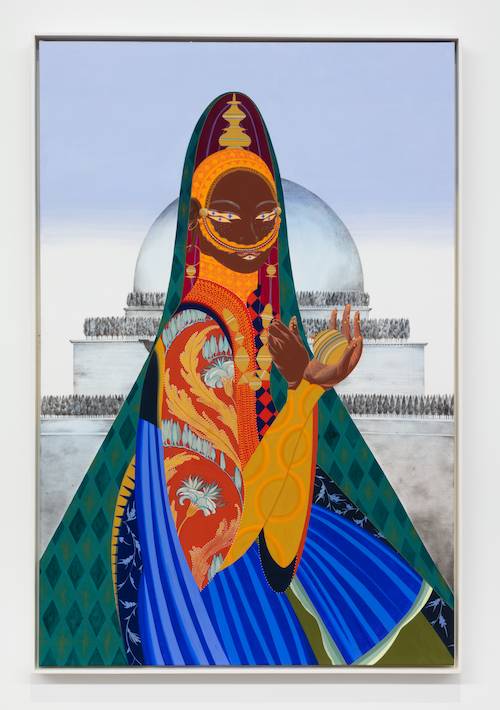Helping Canadian artists gain exposure to wider audiences motivates RBC to share its collection with galleries and public spaces worldwide.
Helping Canadian artists gain exposure to the widest possible audience motivates RBC to share its art collection with galleries and public spaces worldwide.
But it goes beyond promoting their names and work, says Corrie Jackson, RBC’s Senior Art Curator. The bank wants to elevate the ideas and shared values presented through art. So much so that Corrie describes the bank’s efforts to foster global dialogue from its art collection as a “corporate responsibility.”
She points to an RBC commissioned piece by Toronto-based painter Rajni Perera, currently on display at a London, UK gallery. The artist’s work speaks to the “importance of imagining possible futures in a direct way” by portraying a figure whose body elements have been impacted by an environmental disaster while also wearing patterns rich with cross-cultural references.

Rajni Perera, Traveller 6, 2019, mixed media on paper, 100.3 cm x 151.13 cm
More broadly, the bank partners with organizations across Canada to help visual artists, actors, authors, and musicians gain exposure and grow their careers. In 2021, the RBC Foundation donated more than $10 million as part of RBC Emerging Artists to over 185 organizations in Canada, helping to bridge the gap for more than 5,900 emerging artists.
The RBC Community Gallery
To further support and amplify the works of Canadian artists, RBC recently established the first permanent, public-facing display of its art collection, the RBC Community Gallery, located at the bank’s flagship branch in downtown Toronto. The inaugural exhibition, Ecologies and Communities, explores visions of community at a time when the technological revolution and social justice movements are redefining Canadians’ understanding of belonging.
The exhibit begins with a work titled foundations by Metis visual artist Amy Malbeuf, which explores “identity, place, language, and ecology” through a combination of deer hide and reindeer hair, both of which carry cultural significance, and a braided string that she received as a gift. Malbeuf combines contemporary fashion design with Indigenous art-making techniques, creating a unique wall-mounted sculpture. The exhibition continues with eight more artists exploring drawing, printmaking, photography, and digitally reproduced data visualizations.

Amy Malbeuf, foundations 2017, embroidery hoop, deer hide, reindeer hair, and gifted object (braided string), 165 cm x 28 cm x 3 cm
“When you start to get into the depth and intimacy of each piece, it opens up a world of understanding that you don’t get if it’s a piece on the wall that you walk by. And I think having those entry points – like our permanent display — has changed how we value the collection. It is an amazing way for RBC to prompt dialogue and discussion about the world around us.”
Artists shape the way we view the world
The bank began collecting art in 1929 when the Group of Seven was defining Canada’s identity on a global scale. Today there are more than 5,500 pieces in the collection, with an emphasis on living artists and emerging talent. Associate Art Curator Stefan Hancherow believes the mix of legacy and contemporary works goes beyond an ambitious compilation of Canadian artists. He sees it as a record of dialogues spanning time and geographical space.
Importantly, Stefan notes, the works reinforce many of the values that matter to the bank, including diversity and inclusion, community building and a sustainable environment, and which, at the same time, tap into local conversations taking place around the world. “Artists continually shape the way we view the world, their artworks are both windows and mirrors that allow us to re-contextualize histories while simultaneously offering glimpses of the future. Presenting artworks together that were produced across generations reveals themes that artists have frequented, and opens dialogues that can cross borders and eras.”
Maximizing creative potential in individuals and organizations
The bank also recognizes the intrinsic value of sharing its collection. For one, Stefan points out, it helps foster a creative mindset, which RBC sees as the new “it” skill in growing the economy.
“Looking at something with a critical eye can be the beginning of a creative process,” says Stefan. “It makes way for multiple perspectives, allowing people, for instance, to look beyond a singular problem and find solutions. Our collection can foster those kinds of moments.”
According to Corrie, understanding multiple perspectives also builds empathy between colleagues. For instance, one painting may elicit both positive and negative reactions. “It can lead people to reflect on those differences and better understand where others are coming from. That’s an important exercise in building an inclusive culture.”
More than 90 per cent of the collection is on loan at any given time. “Art is made for audiences and to be engaged with,” explains Corrie. “Certainly, the works we acquire are meant to start conversations, largely to help us understand the past or imagine some kind of future. We want to honour the artist’s intent.”
You can view select works from the RBC art collection here
This article is intended as general information only and is not to be relied upon as constituting legal, financial or other professional advice. A professional advisor should be consulted regarding your specific situation. Information presented is believed to be factual and up-to-date but we do not guarantee its accuracy and it should not be regarded as a complete analysis of the subjects discussed. All expressions of opinion reflect the judgment of the authors as of the date of publication and are subject to change. No endorsement of any third parties or their advice, opinions, information, products or services is expressly given or implied by Royal Bank of Canada or any of its affiliates.

